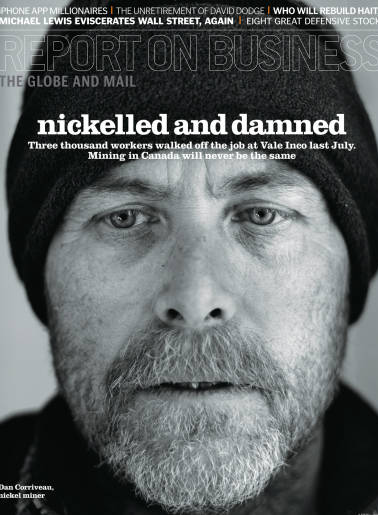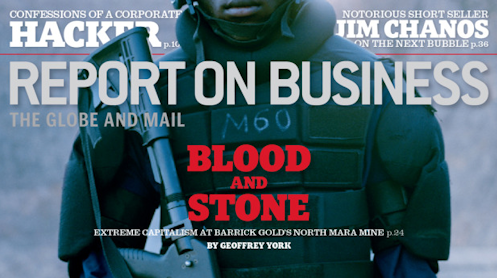Stan Sudol is a Toronto, Canada-based communications consultant, mining columnist and blogger. stan.sudol@republicofmining.com
Biggest commodity super-cycle in the history of mankind
The future of mining has never been brighter, yet its image among the general population seems to have plunged lower than the famous Kidd Creek mine in Timmins, Ontario – the world’s deepest base metal operation. The largest rural to urban migration in the history of mankind is taking place in China. It has been often said, that China needs to build two cities the size of Toronto, Canada and Sydney, Australia to accommodate that growth, every year! Analysts estimate that China’s middle class is expanding so rapidly that it will soon overtake the current U.S. population of 312 million.
In October, 2011, the world’s population had passed the seven billion mark. India, Brazil, Indonesia, Turkey and many other developing countries are following China and urbanizing and industrializing their economies. Mining experts feel that over the next 25 years, we will need to dig out of the ground as many minerals as consumed since the beginning of mankind.
One of the biggest concerns is a shortage of skilled workers. In the next decade half the mining workforce in Canada is eligible to retire and there are significant difficulties attracting and engaging the digital generation.
According to the Ottawa-based Mining Industry Human Resource Council’s 2011 hiring report, the industry will need to hire betwee 75,280 to 141,540 new workers in Canada depending on the state of the global economy by 2021. Similar labour shortage issues exisit in other western mining jurisdicitions like Australia and the United States.
Getting the next generation to enter this booming industry is going to take enormous ingenuity due to the mining sector’s appaling image and reputation.
Outside of the established mining camps the resistance to mineral development among urbanized populations in western countries and many rural regions in developing economies has increased exponentially. Media-savvy environmental movements and NGOs often inflame these conflicts and point to many former mine developments that caused pollution or other problems. They have become the major opposition to most mining developments around the world.
We must be honest with ourselves, as the mining sector has a long history of pollution, disregard to local communities, past safety issues and anti-unionism. The cost of restoring many of these abandoned mines has fallen on governments.
Modern mining practices of the 21st century will not repeat these mistakes and closure costs are incorporated into the economic viability of resource projects while global instant communications helps ensure compliance. Furthermore, the financial fallout – share price declines and the increasing reluctance of many banks to lend money to controversial projects – makes reputation management an integral part of today’s mining corporate culture.
Still too many mining conflicts or problems
However, during the past few years, the many conflicts involving the mining industry, especially in Ontario, Quebec and British Columbia, remind me of a similar spate of problems in the mid to late 1990s that resulted in the unflattering nickname, “The Ugly Canadian” based on a CBC news special. During that time, the industry witnessed a litany of environmental damage from tailings spills in the Philippines, Guyana, Spain, human rights abuses in Indonesia and Papua New Guinea and the spectacular Bre-X mining fraud in 1997 – the largest in mining history.
In a lengthy thought-provoking speech to a mineral symposium in 1999, – “The Ugly Canadians – Shifting Sands: Mining, the Media and Public Perception” – former Northern Miner editor Vivian Danielson summarized the issues of the time, which unfortunately are still all too familiar today.
How things change and how they stay the same! The mining sector has done a terrible job of clearly and transparently explaining the economic benefits and environmental sustainability of their current projects. This increases their costs of doing business through increased red tape, litigation, project slowdowns and potentially bad and unexpected government policies like the Ontario Diamond royalty on DeBeers Canada and the revisions to the province’s mining act.
The controversial attempt to pass the anti-mining Bill C-300 in Ottawa last year, which was eventually defeated, resulted in a large number of negative stories in the mainstream media about mining conflicts in lesser developed countries. Canadian mining project conflicts in Guatemala, Argentina, Mexico, Papua New Guinea and many others were highlighted by the Toronto Star reinforcing a negative image in Canada’s largest population centre.
The 2009-10 year-long Vale strike in Sudbury, with its extensive national media coverage that was largely sympathetic to the union, was one of the most high-profile mining conflicts in the country. Anecdotal evidence indicates that many high-school guidance councilors in the Sudbury region are steering students away from the mining sector. Aside from guidance councilors, many Sudburians who may not even be employed by the industry could not help but notice the personal suffering and anguish local mining families went through during that bitter year. Long-term labour turmoil is certainly an incentive for youth to stay away from an industry.
The issue of Asbestos mining in Quebec and the export of this cancer causing material has been another albatross on Canada and the mining sector. All western medical establishments have condemned the country for allowing this toxic export to poor regions like India where labour standards are weak and workers routinely exposed to this deadly material. Ongoing print and television coverage demonize the country and the industry’s reputation. Is it really worth it? Why doesn’t the mining industry publicly demand that the Asbestos mines be shut down for good for humanitarian reasons?
Last summer, Barrick Gold, Canada’s largest mining company had its reputation severely damaged due to seven deaths at its Tanzanian operations at the hands of security guards. This incident made front page headlines in the country’s two largest circulation papers – the Toronto Star and Globe and Mail. An October, 2011 cover story in the Report on Business Magazine further delved into this tragedy giving the entire industry a negative tarnish.
Furthermore, a recent 11 minute news documentary by well known CBC reporter Wendy Mesley further profiled Canadian mining problems in lesser developed countries and the ineffectiveness of the federal Corporate Social Responsibility Counselor for the Extractive Sector, Marketa Evans. Often, the general public does not distinguish between mining problems in Latin America and Africa or northern Ontario.
http://www.cbc.ca/news/canada/story/2011/10/31/mining-watchdog-agency.html
Currently, the enormous controversy over the Keystone XL pipeline and the Alberta oil sands and even last year’s BP oil spill in the Gulf of Mexico, also have a detrimental influence on the mineral sector. The delay and/or possible cancellation of the strategic pipeline that would have lessoned the U.S. dependency on oil from politically unstable or hostile countries, has been considered a “game changer” by many analysts.
The power and financial clout of environmental NGOs
The power of the environmental NGO’s and their Hollywood backers are becoming a significant issue for any large scale resource project anywhere in the world. A recent commentary in the Globe and Mail – Gary Mason, Sept. 29, 2011 – highlighted the fact that since 2000, approximately $300 million has been funneled into Canadian environmental organizations from American foundations to stop or delay resource projects. These figures were supplied by Vivian Krause – www.fair-questions.com – an independent writer focusing on environmental lobbying efforts in Canada who estimates current funding from U.S. sources at about $50 million a year.
The mining sector is “whistling past the grave” if it thinks a portion of that money is not being directed against mineral projects and lobbying governments for legislative changes like Ontario’s Far North Act which was and still is vehemently opposed by the province’s First Nation’s communities.
Yet if one did an impromptu survey in downtown Toronto, I suspect the majority would probably think that native people are against mining due to two high-profile cases that were extensively covered by the media – Kitchenuhmaykoosib Inninuwug (KI) First Nation versus Platinex Inc. and the Algonguin First Nations and Frontenac Ventures Corporation uranium standoff. Both conflicts sent council members or protestors to jail creating instant Aboriginal martyrs. In addition, Taseko Mine’s Prosperity Mine in British Columbia is bitterly opposed by the local Aboriginal community. This is a very complicated proposal with Aboriginal, environmental and development issues that have not been resolved to everyone’s satisfaction.
Aside from these three main conflicts, there are almost 200 agreements between senior and junior miners and Aboriginal communities across Canada, the largest number, about 90, are in northern Ontario. You would never know about that reading the daily papers or listening to television news.
The successful mining projects at Voisey’s Bay, Newfoundland, Raglan, Quebec, the uranium mines of northern Saskatchewan, the Alberta oil sands and the diamond and gold mines of the Northwest Territories and Nunavut respectively, all extensively involve Aboriginal or Inuit communities. The industry has done an exceptional job of engaging indigenous communities yet have done almost no media outreach about these initiatives. No one to blame except ourselves!
Research has shown that some of the most significant NGO issues in the mining sector are the environmental and social impact of resource development especially on indigenous people. Other major concerns range from tailings disposal and pollution and the ethical sourcing of minerals – blood diamonds and metals – to foreign ownership and asbestos impact on health.
Mine safety was thrust into the public conscious by the gripping human saga of 33 trapped Chilean miners and kept there by the tragic deaths of 29 coal workers at the Massy mine in West Virginia. In total, 48 coal miners died in the U.S. in 2010, while the comparable figure for Chinese coal workers is about 2,433. Sadly, most Canadians are unaware of this country’s leading role in mine safety, which astonishingly is not copied by many U.S. mines due to cost issues.
Even in the realm of popular culture and film, the industry is doing badly. The movie Avatar, which was the highest grossing Hollywood film of all time – almost $2.7 billion – was an anti-mining, anti-development feature film that had a negative impact on the industry’s reputation, especially among the young. A group protesting a proposed bauxite project by Indian miner Vedanta – which required the removal of indigenous inhabitants from their ancestral homelands – dressed up as the fictional blue-skinned tribal people from the movie, at the company’s annual meeting in London. The project was eventually rejected by the Indian government.
And a recent NFB film – Trou Story/The Hole Story – made by Quebecers Robert Monderie and Richard Desjardins chronicles the past devastation and pollution of mining practices in Northeastern Ontario and Northwestern Quebec and calls for the nationalization of mining companies. While the film is obviously biased to the politically left – and financed with our tax dollars – many viewers seldom have an opportunity to see a realistic portrayal of the industry as it operates today.
The PDAC could be much more effective
If I were to assign an animal to the mining industry, it would be an ostrich or a slow moving brontosaurus. A barracuda or keen predator like those fast raptors we saw on the Hollywood movie Jurassic park would symbolize the environmental movement.
Mining Watch gets a lot of media air time because they are ready to respond to reporter requests quickly. On the other hand, the mining sector often does not make their key executives or most knowledgeable people available in the timelines needed in a 24/7 news environment.
The richest mining organization in the country is the Prospectors and Developers Association of Canada (PDAC), the same group who holds the largest mining convention every March in Toronto. Last year, they set another attendance record at about 27,000 visitors. Many in the mining community feel this organization has significantly let down the entire industry with its lack of public and political advocacy.
To be fair they do have a good outreach program called Mining Matters that teaches elementary and high school students and educators about the mineral sector, but this is not nearly enough. Unfortunately, a recent PDAC multi-page advertising insert in Canadian Business did not mention anything about Aboriginal participation in Canada’s mining sector.
During the Bill C-300 issue, a leaked PDAC CSR document, that the organization had an NGO produce, made headline news in the Toronto Star and embarrassed the entire industry.
The Ontario Far North Act is one of the most detrimental pieces of anti-mining legislation in the history of the province. Other than a news release condemning the Act and supporting Aboriginal opposition, the PDAC did no public advocacy advertising to help educate the general public or try to sway the politicians during the initial public hearings. In 2009, I helped write almost half the editorial content for the PDAC’s 75th anniversary publication and was asked to participate in a one day seminar last year, along with a number of industry colleagues to help improve the association’s communications activities. Unfortunately many of the good ideas we collectively came up with were not used.
For a organization that was founded in 1932 to fight an Ontario regulation that was detrimental to the province’s prospectors, at that time, and played a major role in mobilizing its membership to look for strategic metals during the Second World War, the PDAC has become very complacent in defending the industry it represents. There needs to be a significant reassessment on how the PDAC engages the general population, the media and the political elite.
Both General Electric Canada (GE) and the Canadian Association of Petroleum Producers (CAPP) are currently running major public awareness campaigns to educate Canadians about their respective companies or organizations. GE has a much easier time as it is not involved in any contentious issues and wants to build public awareness of the company’s many diverse operations beyond light bulbs and appliances that also includes jet engines, power generation, financial services, and water processing. You can see their newspaper and magazine advertisements in many mainstream publications.
The CAPP public relations campaign has a much harder challenge as the oil sands and Keystone XL pipeline have garnered many environmental protests so their ads are trying to respond to a significant amount of negative news. In addition, they started their advertising too late, only after months of negative publicity. They also have published advertisements in major Canadian publications as well as posted informative videos on their website. http://www.capp.ca/
Even the egg farmers of Ontario has a successful advertising campaign using billboards, transit ads and radio spots that tell the general public about this industry.
The next generation is staying away from the industry
There are some bright initiatives. The Ontario Mining Association engages high school students across the province with its “So You Think You Know Mining” video contest. With a $5000.00 top cash prize, the event has seen a significant increase in entries even from urban-based schools in the south. It’s a great example of an industry initiative focused on students at a time when they are deciding what career paths to take.
Rio Tinto is expanding their production in Canada and needs to hire about 200 people. To attract the best candidates possible, they have produced some of the most innovative advertising that the mining sector has ever seen in this country. Television spots combined with You-Tube postings have garnered enormous media attention.
Why can’t the PDAC do public awareness advertising showcasing the entire mining sector and its solid commitment to Corporate Social Responsibility (CSR) and the alleviation of Aboriginal poverty? The building of schools, health centres, bringing potable water and helping establish supply companies are but few of the many initiatives that are seldom mentioned in the media or advertising initiatives. The fact that Toronto investors get rich from mining development and government-funded flow-through share tax breaks, as one past PDAC advertisement in the Globe and Mail highlighted, is not going to convince the general public that our social license to operate should continue.
We need to become much more pro-active and start telling our own stories. No one else is going to do it for us. Mark Twain once said, “A lie can travel halfway around the world while the truth is putting on its shoes.”
Respected accounting firm Deloitte Touche just released a mining study on the top 10 trends the industry will face in 2012. One of the critical issues is that “there are simply not enough people to power projected mining company growth. … For 2011, mining capital expenditures are estimated at US$113 billion, 50% above previous year levels.” The report asks, “Mining executives must consider how to attract Generation Y into the sector. What will drive good people to want to work in Mongolia or Papua New Guinea?”
However, the report should have asked how do you get a media savvy and socially conscious Generation Y into an industry that has a horrible public reputation? Online communications, social media and the 24 hour TV environment can magnify any problem or conflict anywhere in the world and quickly inform the most digitally wired generation in the history of mankind. Considering the bevy of bad news over the past few years, what parent is going to encourage their children to enter this industry? Societal expectations are demanding higher benchmarks from the mining sector and by-and-large they are responding.
But, until the mineral industry puts the financial resources into telling its success stories and improving its media image, the many needless delays and conflicts that regularly occur – and dominate the front pages of the country’s newspapers and lead stories of the nightly television newscasts – will continue to negatively affect company share prices, increase construction costs as well as postpone badly needed tax revenue for government from potential economic development and jobs.
And the greatest threat from this low societal status and poor reputation is that the next generation of kids who the mineral sector desperately needs in order to find, build and operate the mines of the future, will stay away in droves.
Stan Sudol is a Toronto, Canada-based communications consultant, mining columnist and blogger. stan.sudol@republicofmining.com
Stan Sudol was born and raised in Sudbury, Ontario by parents who were Polish immigrants. His father and most of his neighbours worked for Inco or Falcanbridge. His brother also worked at Inco but spent more than a decade as a miner at Elliot Lake’s uranium mines and afterwards helped decommission them. Mr. Sudol worked for one year at Inco’s Clarabell Mill before returning to college and one summer underground at the Frood-Stobie mine.
Mining is in his blood and he feels the industry can not only help revive Ontario’s depressed economy, but also significantly reduce impoverished living conditions in the north’s Aboriginal communities. He remembers a time when people associated with the mining sector were well respected by the general public, the media and government.




























